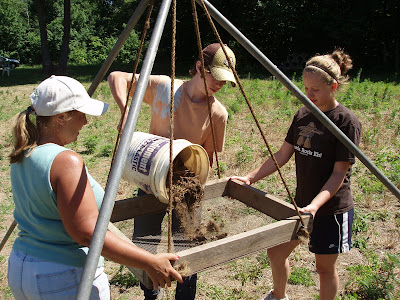The Future Scientists teamed up with the Student Naturalists to visit Dr. Joe Keiper, CMNH's Curator of Invertebrate Zoology, at his house. Why? To dig up a white-tailed deer and pygmy hippo buried in his yard. This was a truly unique experience - if nothing else to work with the pygmy hippo's remains, a truly endangered animal. Read more about the pygmy hippo at the animal diversity web.
Dr. Keiper had the brainchild to bury these animals in his yard two years ago when the Zoo's pygmy hippo passed away, figuring he could let nature clean up the bones for him, and adding a memorable experience for students who get to excavate the bones for the museum's collections. Such is the thinking of a man who studies how maggots decompose dead bodies. Those fortunate enough to know Dr. Keiper can ask for a thrilling recount of how he brought the dripping, bloody 400 pound animal back to his house with unknowing Sheriff in tow.
Anyway, after two years, the animal bodies should have been adequately decomposed, and Dr. Linda Spurlock, CMNH's Director of Human Health and Anatomy graciously offered to show the students careful archaeological technique in excavating the bones.
 Dr. Spurlock gets down and dirty.
Dr. Spurlock gets down and dirty. The Future Scientists use the shake screen to make sure small bones (and missing jewelery) are not missed.
The Future Scientists use the shake screen to make sure small bones (and missing jewelery) are not missed. As layers of earth are removed, the students come across a skull! The skull looks happy.
As layers of earth are removed, the students come across a skull! The skull looks happy. Skull successfully extracted. White-tailed deer.
Skull successfully extracted. White-tailed deer. Wheel-barrel of deer bones.
Wheel-barrel of deer bones.Well, after two years, the bodies likely would have all decomposed. That is, unless you left them in a plastic bag. Like Dr. Keiper did. But hey, if you were digging a hole all by yourself to bury 500 pounds of stinky dead animal, what would you have done?!
 Meat still clinging to the bones. We'll save that for next year.
Meat still clinging to the bones. We'll save that for next year. Hippo skull successfully extracted. Nice and clean - good job, Nature!
Hippo skull successfully extracted. Nice and clean - good job, Nature! The hole was reburied and concrete blocks were piled on top to prevent coyotes or other scavengers from dragging away the precious bones. Students will check out the scene again next year to hopefully extract the bones for the museum's collections.
The hole was reburied and concrete blocks were piled on top to prevent coyotes or other scavengers from dragging away the precious bones. Students will check out the scene again next year to hopefully extract the bones for the museum's collections.














































